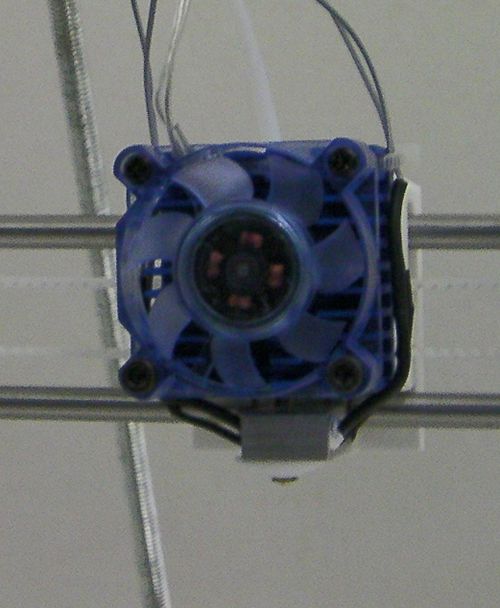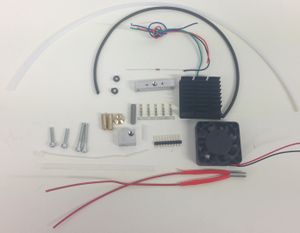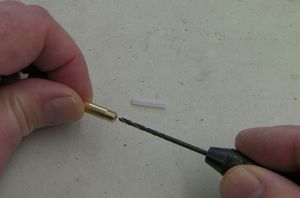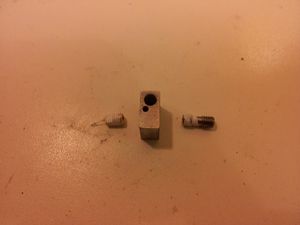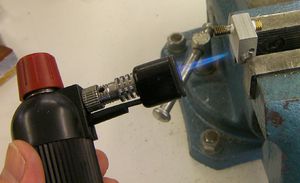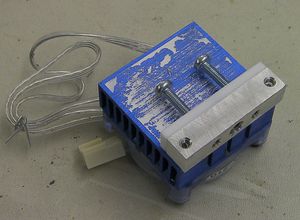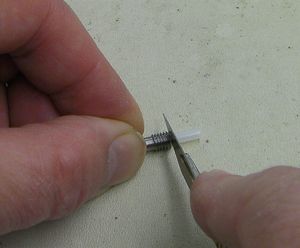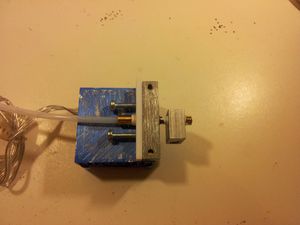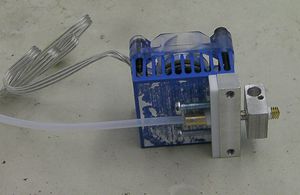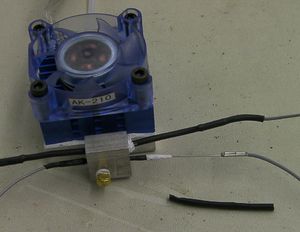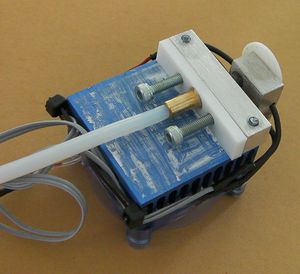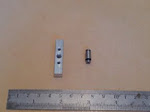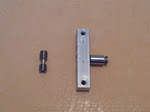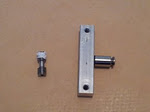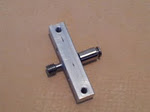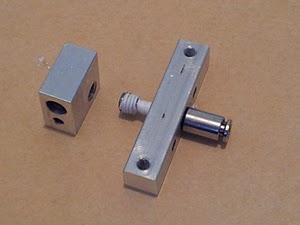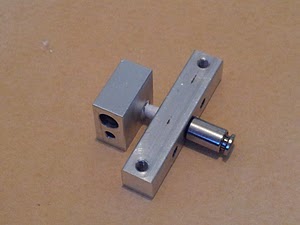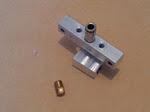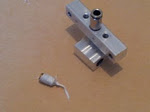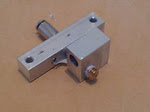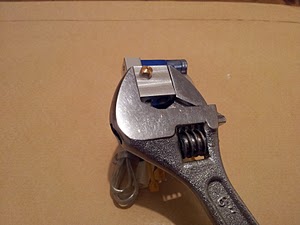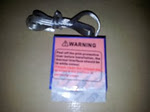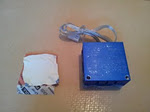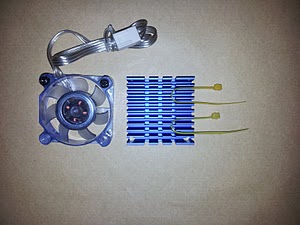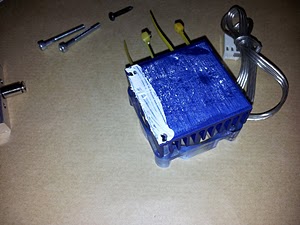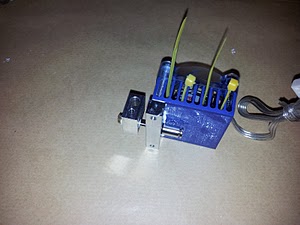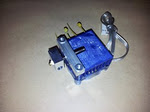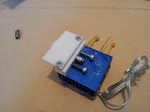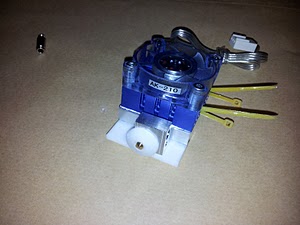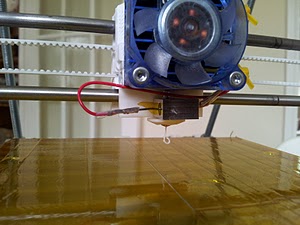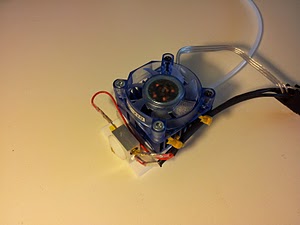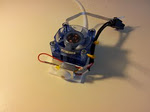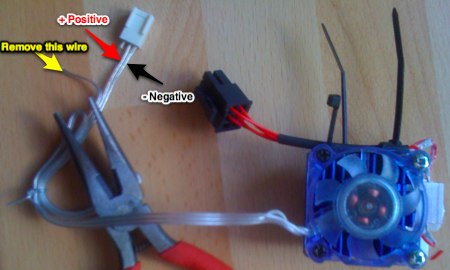RepRapPro Huxley hot end assembly
| Introduction | Frame assembly | Y axis assembly | X axis assembly | Z axis assembly | Heated bed assembly |
| Extruder drive assembly | Hot end assembly | Installing the electronics | Wiring | Commissioning | Printing | Troubleshooting |
Contents
- 1 This page is under construction
- 2 Goal
- 3 Tools
- 4 Parts
- 5 Step 1: The hot part of the hot end
- 6 Step 2: The cooling system
- 7 Step 3: The heater resistor and temperature-measuring thermistor
- 8 Step 2: Assemble the machined parts
- 9 Step 3: Attach the fan assembly
- 10 Step 4: Fit the heat shields
- 11 Step 5: Add the electrical components
- 12 Next step
This page is under construction
Goal
By the end of this stage you will have finished all the mechanical construction! Your hot end will be fitted to your Huxley like this:
Tools
You will need the following tools:
- Allen key
- Small screwdriver
- Pliers
- Adjustable spanner
- Heat sources (small blowtorch plus hairdryer/soldering-iron)
- Bench vice
Parts
Sharp eyed readers will notice that the PTFE rectangle with two holes in the loop of wire in the picture is not in the list on the left. It is an old part that may still be in your kit. It is no longer needed.
There are several stages in this construction where you have to trim pieces of PTFE. It is essential to clear any swarf created away and not to let it get into the extruder. PTFE swarf will travel to the nozzle and block it if it is allowed to contaminate the device.
Step 1: The hot part of the hot end
Take the PTFE tube from the extruder drive that you just made. Cut a short length (about 15mm) from its free end using a sharp blade, taking care to make the cut square on to the axis of the tube. Put the short length aside for use later.
Screw the brass union onto the end of the PTFE tube that you have just cut. By looking down the other end of the brass you will be able to see when the PTFE reaches the end of the thread.
Screwing the tube in will have reduced its internal diameter slightly. Gently twist a 2mm drill by hand in the end of the brass to thin the tube where it is inside the screw thread. If you have a small hand-chuck this is made easier:
Push a short length of 1.75mm build filament down the tube from the other end to clear out any PTFE swarf (see the warning above about leaving any behind).
Wrap plumber's PTFE tape round the shorter thread of the stainless steel barrel and the nozzle:
(The picture shows the longer steel thread wrapped too. Don't do this yet.) Take care that the tape does not cover the holes, and leave the smooth part of the barrel free (or trim the tape away from that with a blade after wrapping). The barrel has a big temperature drop in operation from one end to the other (around 200oC), so it is important that you leave the middle surface free to radiate heat.
Screw the barrel and the nozzle into the heater block so they meet in the middle. The nozzle goes in the side of the aluminium block with the small 2mm through-hole (that will later accommodate the temperature-measuring thermistor).
Offer up the PTFE insulating cone beside the nozzle. The nozzle should stick out of the block a bigger distance than the depth of the cone. The cone will be screwed onto the nozzle later, and the nozzle needs to project out the bottom.
Place the assembly in the corner of a vice, gripping as little of it as is compatible with its being secure. Adjust the adjustable spanner to the flats on the nozzle and have the long-nosed pliers to hand.
Use the blowtorch to heat the block:
You need to heat the block enough for it to expand by at least the amount it will expand during printing. Neither the brass nozzle nor the stainless steel barrel will expand as much as the aluminium heater block. So, whilst hot, hold the steel coupling with the pliers and tighten the nozzle with the spanner. This will normally take only a very small amount of rotation (say 1 or 2 degress) but will be enough to ensure the nozzle assembly does not leak during printing.
Leave the block in the vice to cool.
Step 2: The cooling system
Peel the sticky backing off the fan and heatsink. This is quite tough - you may need to pull with pliers. Take care not to put stress on the delicate plastic fan.
You can put a little heatsink grease on the aluminium cooling block if you like. Attach it to the fan with the two longer screws. Put the two shorter screws through the PTFE spacer and screw them a few turns into the block.
Take the short length of PTFE tube you saved and put it in the counterbored hole in the stainless steel barrel. Trim it flush with a sharp blade:
Take a 5mm drill and gently twist it against the end of the PTFE that you have just created to dish it slightly. Make sure you clear all swarf away.
Wrap more plumber's tape round the stainless steel barrel thread and the brass union on the end of the PTFE tube. Again take care that the tape does not cover the holes, and leave the smooth part of the barrel free (or trim the tape away from that with a blade after wrapping).
Screw the stainless steel barrel into the aluminium cooling block until the thread is all inside (or almost all inside) and the heater block is square as shown. Screw the brass union in with its PTFE tube to meet in the middle. Tighten the brass union with long-nosed pliers.
Step 3: The heater resistor and temperature-measuring thermistor
Check that the heater resistor fits in the larger hole in the heater block. The resistors can be a little variable in their diameter. If the resistor is too big, clamp the heater block firmly in a vice and run a 5mm drill down it. Be careful to run it square on. Running the drill up and down will shave a little off the sides of the hole. Repeat this until the resistor fits.
If the resistor is too small, wrap it in a little PTFE tape.
Bare about 10mm on the end of two connector wires and crimp them onto the ends of the resistor's leads. Put heatshrink on and use a soldering iron or hairdryer to shrink it.
The picture shows the left-hand side complete, and the right hand side waiting for the crimp to be slid over the join followed by crimping.
The thermistor should fit in its hole - they are manufactured to a tighter tolerance. It will be a little undersized. But the crimps on the thermistor wires won't fit through the hole, so you have to crimp one wire after the thermistor has been pushed through the block.
Wrap the thermistor in PTFE tape, crimp a wire onto one end only, and shrink heatshrink onto that. The heatshrink should come up to the thermistor, over the PTFE tape that will be on its lead, but must not cover the thermistor itself.
As shown above, push the free end of the thermistor through the block until the thermistor comes out the other side, and repeat the wire connection procedure on the unconnected end.
Bend the wires up the side of the heat sink. Do not pull them tight - they need a little slack to accommodate movement and expansion. Attach them at the top of the heatsink with two cable ties chained together, one of them running through the top slot in the heatsink.
Screw the PTFE insulating cone onto the nozzle.
Use the two free screws in the aluminium cooling block to attach the extruder hot end to the X carriage of your Huxley. The PTFE tube clips into the printed vertical channel in the X carriage.
Put the free end of the PTFE tube back in the extruder drive and re-secure it with the tongue that you undid at the end of the previous page.
The tube runs outside the machine. It does not run between the threaded rods.
Follow these instructions to prepare your thermistor.
Step 2: Assemble the machined parts
Screw a pneumatic fitting into the heatsink block by hand as far as you can. Coat the countersunk end of the barrel in heatsink compound and screw this into the other end of the heatsink block, again by hand until it butts against the pneumatic fitting.
Now unscrew the pneumatic fitting by up to 1/2 a turn, then screw the barrel in a little further until it stops. Now tighten the pneumatic fitting by gripping its outer diameter with a pair of pliers.
Wrap some PTFE plumber's tape around the free end of the barrel, ensuring you wrap in the direction of the threads, so that when you screw the barrel into the heater block, the PTFE tape stays in place.
Screw the heater block onto the barrel to the end of the thread. NOTE the orientation of the heatsink block in the image above.
NOTE: Before fitting the brass nozzle, it is worth ensuring the inside is clean. Although a contaminated melt chamber will not break your machine, it will likely cause failed prints.
Wrap the nozzle in PTFE plumber's tape, again ensuring it follows the direction of the threads, and screw this into the open end of the heater block, by hand, until it butts against the barrel.
Hold the heater and heatsink blocks in one hand, ensuring they are parallel, then tighten the nozzle using the pliers. Do not try to overtighten at this stage, the trick comes next, (if you do not like the idea of the following instruction, there is an alternative solution which will be given after the hot end is wired and connected to the electronics).
Hold the heater block with an adjustable spanner (mole grips would also work), and heat the heater block with the blowtorch.
This needs to be a powerful heat source as you need to heat the Aluminium heater block enough for it to expand by at least the amount it will expand during printing. Neither the brass nozzle nor the stainless steel barrel will expand as much as the Aluminium heater block, so whilst hot and holding the cold end of the spanner, tighten the nozzle with the pliers. This will normally take only a very small amount of rotation (say 1 or 2 degress) but will be enough to ensure the nozzle assembly does not leak during printing.
Step 3: Attach the fan assembly
Prepare the fan assembly by removing the adhesive tape from the back face of the heatsink. DO NOT discard this tape as it can be cut and used to attach the SMD heatsinks to the A4988 stepper driver ICs.
Fit a couple of zip ties between the fins (which will later be used to secure the hot end wiring).
Now spread a thin layer of heatisnk compound on the back face of the heatsink between the 3.2mm diameter holes.
Using 2 M3x25mm screws to attach the fan assembly to the heatsink block, with the heatisnk block protruding below the fan assembly.
Step 4: Fit the heat shields
The PTFE heat shield attaches to the heatsink block using the 2 M3 countersunk screws and is stood off the block using an M3 washer over each hole.
The heat spacer (the PTFE strip with 3 holes in it) slides over the pneumatic fitting and has an M3x16mm screw fitted in each of the outer holes. These screws should only be screwed in a couple of turns as they are used to mount the hot end to the nozzle mount on the X carriage.
The final step is to screw the PTFE nozzle shield onto the nozzle.
NOTE: the nozzle must protrude beyond the PTFE nozzle shield.
If this is not the case, cut some material from the nozzle shield with a craft knife (PTFE is quite soft). If the nozzle shield will not screw right up to against the Aluminium heater block, cut some material from the bottom of the PTFE shield plate.
Step 5: Add the electrical components
The power resistor can now be fitted inside the heater block. This needs to be a push fit into the hole, so if it's a little loose, wrap a small amount of Kapton tape around the resistor and push it into place. Trim the resistor wires to about 10mm in length.
Assemble your thermistor as per these instructions, leaving the PTFE insulated wires approximately 90mm long.
For the resistor wires, cut one to 90mm in length, and another to 120mm. Crimp or high temperature solder a crimp terminal onto one end of each of these wires, and insulate with a short length of PTFE heatshrink.
Fill the thermistor hole in the heater block with heatsink paste, then push the crimp terminals onto the resistor wires, push the thermistor into its hole, and secure all of the wires using the two zip ties which were earlier fitted between the fins of the heatsink. Using two zip ties ensures the wires do not snag on other machine components during printing, and also ensures the thermistor remains in the hole.
Crimp or solder a male pin onto each of the free wire ends, then push these into the female 6-way molex connector.
Cut the fan wires to a suitable length, and fit a male pin onto the two leftmost fan wires (when looking at the fan as from the image below).
Alternately working from the plug end see picture below:
Push these into the last two positions of the female molex connector. The leftmost wire in the diagram above must be connected to ground, and the central wire to 19v.
